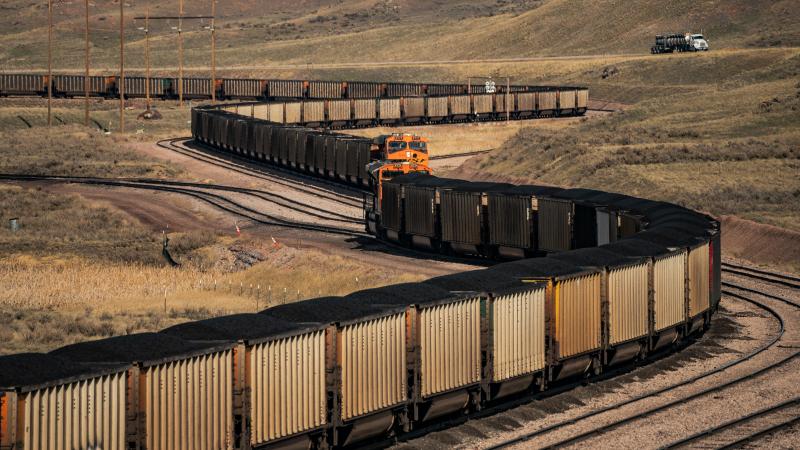Solar farm the size of 2,500 football fields destroyed in Texas amid growing solar e-waste problem
The hailstorm struck the 3,204-acre "Fighting Jays" solar farm — the equivalent of nearly 2,500 football fields. Aerial video shows panels shattered with multiple impact points all along the fields of panels.
A massive solar farm near Houston, Texas, suffered extensive damage from a hail storm. Hail presents a major risk to solar farms, which can add to a growing e-waste problem from the industry.
The hailstorm struck the 3,204-acre "Fighting Jays" solar farm — the equivalent of nearly 2,500 football fields — on March 17. Aerial video shows panels shattered with multiple impact points all along the fields of panels.
A YouTube channel called “Bouken is Adventure,” about a couple of “empty nesters” who make videos about their travels, posted a video about the damage to the solar farm. The couple lives near Guy, Texas, where the facility is located.
Ian McConkey explains in a video that the storm produced 3.5 inches of rain in 15 minutes, as well as a “tremendous amount of hail.” Some reports, McConkey said, measured softball-sized hail.
“Look at the hail hits on the panels. We’re talking 590,000 panels,” McConkey said, as he takes video of the damaged solar farm from a vehicle.
Solar farms wear out over time. While panels can last 40 years, their production efficiency declines considerably after 25 years. According to the National Renewable Energy Laboratory (NREL), after 20 years, a solar cell’s energy production declines 10%. The cumulative waste volumes that will be produced as solar panels reach the end of their useful life, according to NREL, will be as much as 78 million tons by 2050.
That doesn’t include panels destroyed by weather events.
According to the Federal Emergency Management Agency hail risk map, Fort Bend County — where the Fighting Jays solar farm is located — is an area of relatively moderate risk. Other areas of Texas, which generated 15 million megawatt hours of solar power in 2021, are rated relatively high or very high for hail risk.
No risk to the community
According to ABC13 News, a neighbor who lives next to the facility is concerned about toxic chemicals from the broken panels. Some panels use cadmium telluride, which, according to the one study, can produce problems in the kidneys, heart, skin and lungs. The man living next to the facility told ABC13 News his household uses well water, and he is concerned that the chemicals would leak into the groundwater.
A spokesperson for Copenhagen Infrastructure Partners KS, which owns the facility, told Just The News that the panels at the facility are silicon-based and don’t use cadmium telluride.
“We are currently assessing the extent of the impact of the storm on the generation of the project, while the plant continues to safely operate at a reduced capacity. The silicon-based panels contain no cadmium-telluride, and we have identified no risk to the local community or the environment,” the spokesperson said.
The spokesperson didn’t respond to questions about what would happen to the unsalvageable panels at the facility.
David Blackmon, an energy analyst who publishes “Energy Absurdities,” told Just The News that the destroyed panels may end up in a landfill, because it takes time to create an economically viable recycling stream.
“This is common in any industry. The recycling capabilities are going to lag behind the growth of the industry itself, because the market has to exist first before the recycling becomes economic. And there's very little actual recycling capacity in this country in any event,” Blackmon said.
Recycling challenge
B.F. Randall, who has a background in mineral project development and finance, explained on his “Mining Atoms” Substack that the polysilicon in many solar panels, including the ones at the Fighting Jays facility, can’t be recycled.
“Polysilicon is anything but renewable. It’s not even recyclable for use as polysilicon and requires constant replacement,” Randall explains in an article on his Substack.
Producing the material requires coking coal, also known as metallurgical coal. It’s a form of coal that burns much hotter than the thermal coal used in electricity generation, and so it’s used in a variety of heavy industries.
As with any e-waste product, some of the other materials can be extracted from defunct solar panels, such as the glass, copper and aluminum, and these can be recycled into other products.
In 2023, a smaller solar farm in Scottsbluff, Nebraska, was destroyed by hail. That facility was a little more than 4 megawatts in capacity, whereas the Fighting Jays facility is 350 megawatts.
According to the Nebraska Public Power District, the damaged panels were removed from the site and sent to SOLARCYCLE, a facility in Odessa, Texas. In a press release, the company claimed that 95% of the value of the panel can be extracted and sold into other supply chains.
The company didn’t respond to questions about its capacity to deal with the large number of panels destroyed at the Fighting Jays facility, the company’s process, or if the recycled materials are cheaper than virgin products on the market.
A report from the University of New South Wales predicts large volumes of solar waste in Australia beginning in 2030. According to the report, a 40-pound solar panel will produce approximately $20 worth of materials when recycled.
According to energy consulting firm Wood MacKenzie, solar panels cost $3.30 per watt, meaning a 40-pound panel producing about 600 watts would cost approximately $2,000.
The average American home consumes 899,000 watt hours per month. A 600-watt panel with one hour of good sunlight produces 600 watt hours.
According to the MIT Technology Review, only about 10% of panels in the U.S. are recycled.
As the waste stream from solar farms swells with the growth of the industry, more recycling facilities will come online to deal with the waste. Whether that will create an economically viable supply chain remains to be seen.
The Facts Inside Our Reporter's Notebook
Links
- Fighting Jays Solar
- Bouken is Adventure
- Ian McConkey explains in a video
- solar cellâs energy production declines 10%
- according to NREL
- hail risk map
- generated 15 million megawatt hours of solar power in 2021
- According to ABC13 News
- according to the one study
- Copenhagen Infrastructure Partners KS
- Energy Absurdities
- Mining Atoms
- explains in an article
- burns much hotter than the thermal coal
- destroyed by hail
- SOLARCYCLE
- produce approximately $20 worth of materials
- solar panels cost $3.30 per watt
- 40-pound panel producing about 600 watts
- 899,000 watt hours per month
- only about 10% of panels
















